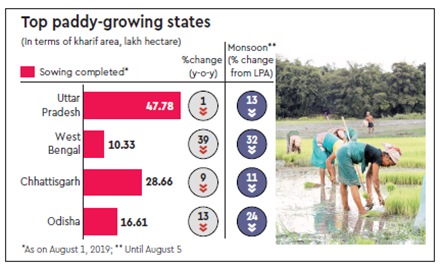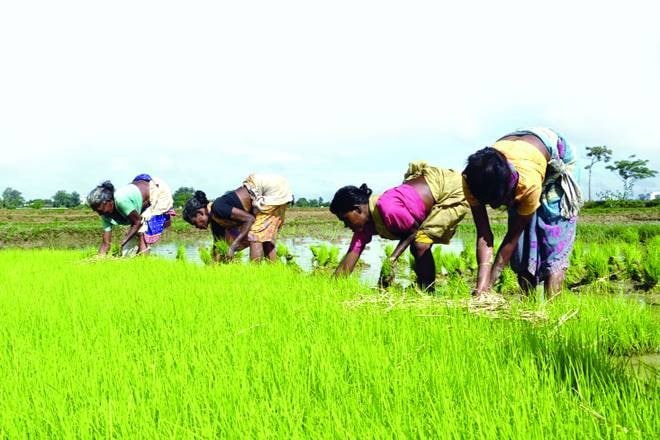West Bengal, India’s top rice-producing state with 15% share in the country’s rice output, has received 32% deficit in rainfall this monsoon season with the precipitation in its top four producing districts being 43-50% lower than the long period average (LPA).
With the state’s overall sowing area under paddy down by 39% (y-o-y) as on August 2, any further delay in rains could bring down production of the cereal in the state and the country as a whole.
The sowing window for this crucial crop is almost over but transplanting will continue to take place till month-end, allowing the area under the crop to increase.
In fact, the paddy sowing area as on August 2 was 12.5% lower than a year ago, worse than the situation a week ago, when the deficit was 6%.
Odisha and Chhattisgarh, which are also major rice producers, are currently facing deficient monsoon rainfall. These states, may, however, benefit from the good spell of rainfall predicted for this week and further. Both these states have about 9% share, each, in the country’s kharif paddy area of nearly 40 million hectare.
But because of lower yield compared to states like Punjab and Tamil Nadu, these eastern states contribute about 6% each in the rice output of the country. The paddy acreages in Uttar Pradesh and Punjab too were marginally lower as on August 2 from the year-ago level and are not likely to improve significantly. Since farmers in both these states get irrigation from groundwater, the marginal rain deficit is not likely to impact production in a big way, an agriculture ministry official said.
However, it is too early to predict the impact of the rain deficit in certain areas and decline in sowing acreage of crops like paddy and pulses, on the agriculture output. Last year, the monsoon rains were 9% below normal or 91% of LPA, yet the country’s food grain output for the year was a record 283.4 million tonne.
Farmers in Burdwan, Birbhum, Nadia and Hooghly, which together contribute 33% of West Bengal’s rice production, would do well to stop sowing activity now, said Mahashweta Bhawmik, technical officer of the agrimet division of the India Meteorological Department (IMD).
“The paddy which are 35 days old in nurseries should be transplanted in the field from now onwards,” she told FE.
The lower area under paddy was mainly due to delayed arrival of monsoon and high level of rainfall deficiency in June and until mid-July in those four districts, she said. Farmers who could not sow paddy, should shift to pulses like moong, she added.
The IMD has said that the low-pressure area lies over north Bay of Bengal and adjoining coastal areas of West Bengal, which augurs well for rains in August. “It (low-pressure area ) is likely to become more marked during next 48 hours. Monsoon trough continues to pass along its near normal position and is likely to remain active during next 3-4 days. Fairly widespread to widespread rainfall with isolated heavy to very heavy falls are very likely over Odisha, south Chhattisgarh, south Madhya Pradesh, Madhya Maharashtra, south Konkan & Goa, Gujarat region, Kerala, Karnataka and northern parts of Andhra Pradesh and Telangana during next 4-5 days,” IMD said in a statement.
Rice is the key cereal in the country’s food grain output having 40% share in 2018-19 and about 90% is produced during kharif and the remaining 10% comes from rabi season. The target for rice production has been fixed at 116 million tonne this year (both kharif and rabi seasons after the country harvested a record 115.63 million tonne in 2018-19.


